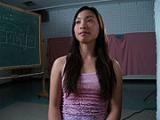
Three-point lighting
Encyclopedia

Video
Video is the technology of electronically capturing, recording, processing, storing, transmitting, and reconstructing a sequence of still images representing scenes in motion.- History :...
, film
Film
A film, also called a movie or motion picture, is a series of still or moving images. It is produced by recording photographic images with cameras, or by creating images using animation techniques or visual effects...
, still photography
Still photography
Still photography may refer to:* unit still photographer, a person who creates still photographic images for the publicity of films and television programs* other photography producing still images...
and computer-generated imagery
Computer-generated imagery
Computer-generated imagery is the application of the field of computer graphics or, more specifically, 3D computer graphics to special effects in art, video games, films, television programs, commercials, simulators and simulation generally, and printed media...
. By using three separate positions, the photographer can illuminate the shot's subject (such as a person) however desired, while also controlling (or eliminating entirely) the shading and shadows produced by direct lighting.
The key light
Key light
The key light is the first and usually most important light that a photographer, cinematographer, lighting cameraman, or other scene composer will use in a lighting setup. The purpose of the key light is to highlight the form and dimension of the subject. The key light is not a rigid requirement;...
, as the name suggests, shines directly upon the subject and serves as its principal illuminator; more than anything else, the strength, color and angle of the key determines the shot's overall lighting design.
In indoor shots, the key is commonly a specialized lamp, or a camera's flash. In outdoor daytime shots, the Sun
Sun
The Sun is the star at the center of the Solar System. It is almost perfectly spherical and consists of hot plasma interwoven with magnetic fields...
often serves as the key light. In this case, of course, the photographer cannot set the light in the exact position he or she wants, so instead arranges it to best capture the sunlight, perhaps after waiting for the sun to position itself just right.

Fill light
In television, film, stage, or photographic lighting, a fill light may be used to reduce the contrast of a scene and provide some illumination for the areas of the image that are in shadow...
also shines on the subject, but from a side angle relative to the key and is often placed at a lower position than the key (about at the level of the subject's face). It balances the key by illuminating shaded surfaces, and lessening or eliminating chiaroscuro
Chiaroscuro
Chiaroscuro in art is "an Italian term which literally means 'light-dark'. In paintings the description refers to clear tonal contrasts which are often used to suggest the volume and modelling of the subjects depicted"....
effects, such as the shadow cast by a person's nose upon the rest of the face. It is usually softer
Soft light
Soft light refers to light that tends to "wrap" around objects, casting shadows with soft edges. The softness of the light depends mostly on the following two factors:*Distance. The closer the light source, the softer it becomes.*Size of light source...
and less bright than the key light (up to half), and more to a flood. Not using a fill at all can result in stark contrasts (due to shadows) across the subject's surface, depending upon the key light's harshness. Sometimes, as in low-key lighting
Low-key lighting
Low-key lighting is a style of lighting for photography, film or television. It is a necessary element in creating a chiaroscuro effect. Traditional photographic lighting, three-point lighting uses a key light, a fill light, and a back light for illumination...
, this is a deliberate effect, but shots intended to look more natural and less stylistic require a fill.
In some situations a photographer can use a reflector (such as a piece of white cardstock mounted off-camera, or even a white-painted wall) as a fill light instead of an actual lamp. Reflecting and redirecting the key light's rays back upon the subject from a different angle can cause a softer, subtler effect than using another lamp.
The back light
Backlighting (lighting design)
Backlighting refers to the process of illuminating the subject from the back. In other words, the lighting instrument and the viewer are facing towards each other, with the subject in between. This causes the edges of the subject to glow, while the other areas remain darker. The backlight can be a...
(a.k.a. the rim, hair, or shoulder light) shines on the subject from behind, often (but not necessarily) to one side or the other. It gives the subject a rim of light, serving to separate the subject from the background and highlighting contours.
Back light or rim light is different from a kick in that a kick (or kicker) contributes to a portion of the shading on the visible surface of the subject, while a rim light only creates a thin outline around the subject without necessarily hitting the front (visible) surface of the subject at all.
Four-point lighting

Background light
The background light is used to illuminate the background area of a set. The background light will also provide separation between the subject and the background. In the standard 4-point lighting setup, the background light is placed last and is usually placed directly behind the subject and...
, makes for a four-point lighting setup.
The background light is placed behind the subject(s), on a high grid, or low to the ground. Unlike the other three lights, which illuminate foreground elements like actors and props, it illuminates background elements, such as walls or outdoor scenery. This technique can be used to eliminate shadows cast by foreground elements onto the background, or to draw more attention to the background. It also helps to off-set the single eye nature of the camera, this means that it helps the camera give depth to the subject.

